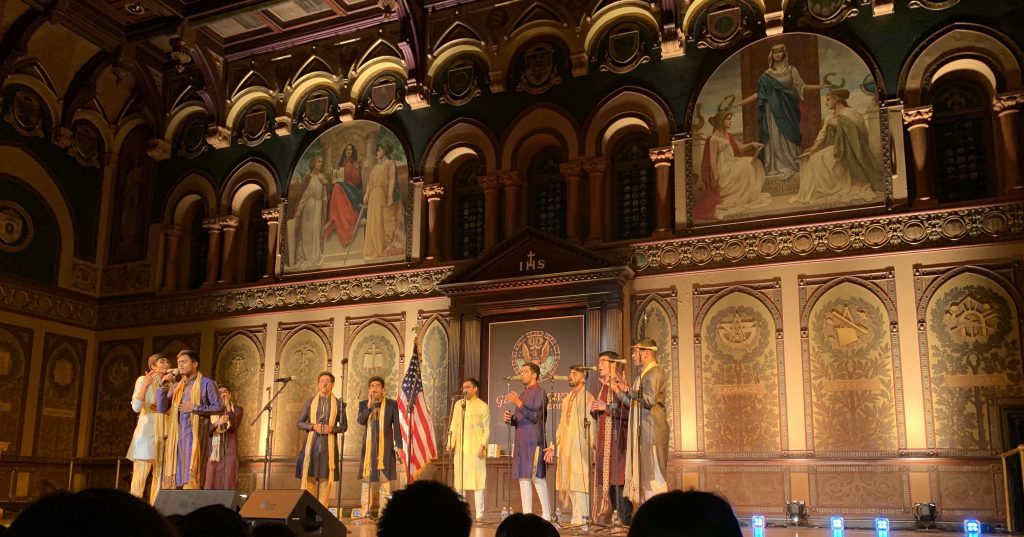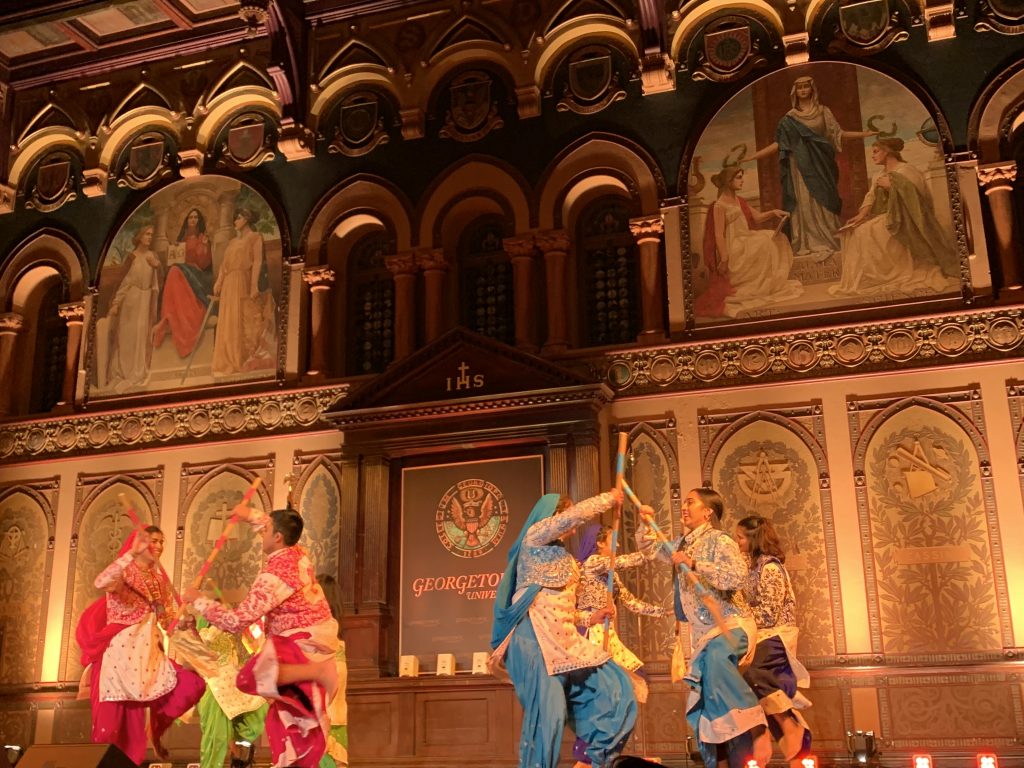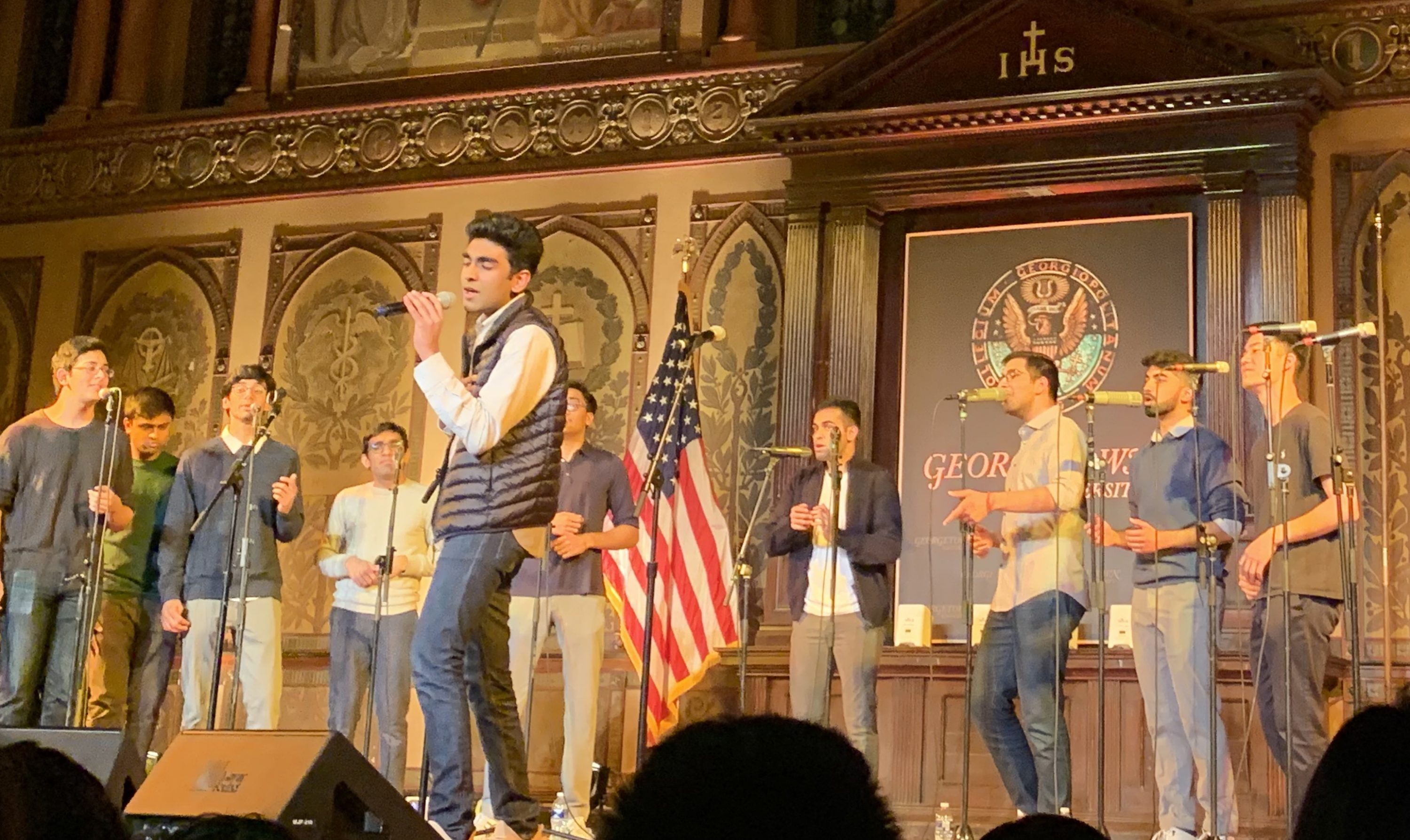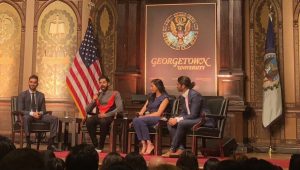The South Asian student organizations of Georgetown, George Washington University, and American University hosted Penn Masala and various South Asian student dance groups at Gaston Hall in front of a sold-out crowd on Feb. 21. The world’s first South Asian a cappella group, Penn Masala was formed in 1996 at the University of Pennsylvania and its popularity across the world has only risen since. The current undergraduate members performed at Gaston as the second stop in their Musafir tour, following the release of their seventh full-length studio album Musafir.
Not only was the event a celebration of South Asian performing arts, it was also a fundraising effort spearheaded by GU South Asian Society (SAS) in support of Spandana Society in Hyderabad, India, a home for 80 underserved children. The fundraiser is a part of their commitment to giving back to South Asian nonprofits
This was the first event of its kind: a D.C.-wide South Asian event organized by student groups across the city’s many universities. The night consisted of three Penn Masala sets, interspersed with student performances by South Asian dance groups from Georgetown and GW. Regardless of how the show advertised Penn Masala as its main attraction, the real stars were all of the student performers—Penn Masala’s arrival served as a way to bring attention to the many talented student groups across D.C.
 Photo by Chetan Dokku
Photo by Chetan Dokku
Penn Masala’s first set opened on a high note with “Cake by the Ocean / Ghungroo (Bells) / Stronger” from their latest album. With a clever reference to Indian actress Priyanka Chopra and her husband Nick Jonas during the “Cake By the Ocean” section, “I’ll be Nick, you’ll be Priyanka, woah-oh,” they put their South Asian touch on American pop music. Like many of their tracks, this one is a blend of Hindi film music and English songs. Most of the Hindi songs tend to be hits with widespread popularity, especially among South-Asian American students. They followed it up with two songs in the same format, “Castle On The Hill / Ilahi” and “The Remedy / Khabar Nahin (No News),” which were also superb. Next was “Aicha,” a Hindi, English cover of the song by Danish band Outlandish. They ended the set with a fusion of two Hindi songs, “Tu Hi Hai (You Are the One) / Jaane Kyon Log Pyaar (Know Why People Love).”
After the first set, Georgetown’s own GU Jawani got the crowd roaring as they performed explosive, energetic Bhangra dance numbers. Bhangra, a traditional style of dance from the Indian state of Punjab, began as a celebration of the spring harvest season, but is now one of the most recognizable styles of South Asian dance with its many kicks and leaps. Gaston’s revered stage, one that has easily accommodated many important figures like Barack Obama and Jane Fonda, felt too small for Jawani’s fiery performance. All throughout their set, audience members yelled the names of their performing friends, cheering them on. It was mesmerizing to see their coordinated dance movements as they would all jump up into the air at same moment and come back down perfectly synchronized. Watching them perform made me question why they’re not asked to perform at more events.
GW Naach followed up Jawani’s spirited dancing with their fusion performance. Billed as GW’s only co-ed recreational Bollywood fusion dance group, Naach performed their signature style by combining classical Indian dance styles like Bharatanatyam and Kathak with Spanish songs. In contrast to the modernness of Bollywood dance, the traditional forms of Bharatanatyam and Kathak have an ancient history and are strongly associated with the religion of the Indian subcontinent.
Then, Penn Masala got back up on stage, this time in traditional Indian attire, for their second and most personal set of the night. In general, the songs were slowed-down and emotional, perfect for their crooning vocals. Their first song was “Photograph / Aayat (Verses of the Quran) / Laal Ishq (Red Love),” which, according to the group, has a special place in their heart because the music video contains lots of home footage of them as children. They followed it up with my favorite song of the night, “She Will Be Loved / O Re Piya (Oh My Dear),” which perfectly complemented their singing style. Before performing the last song of the set they asked, what had to be a rhetorical question, to a crowd full of South Asians: “Are there any Shah Rukh Khan fans here?” They then proceeded to perform a cover of the beloved Indian song “Chaiya Chaiya” from the Hindi film Dil Se.. (1998) starring Shah Rukh Khan, one of the most successful actors in the world and an extremely influential figure in Indian culture. This was definitely the best set of the night.
 Photo by Chetan Dokku
Photo by Chetan Dokku
GUzaarish followed up this stellar performance. As Georgetown’s co-ed Bollywood fusion dance team, GUzaarish’s repertoire consisted of hit English and Hindi songs like “Believer” by Imagine Dragons, “DNA” by Kendrick Lamar, and “Pinga” from Bajirao Mastani (2015). They put up an incredible debut performance, although not as spirited as their friends in Jawani, but still just as effective energizing the crowd. I did not expect such a fantastic performance in their first public appearance.
GW Chamak, the university’s all-female fusion dance team, followed up this performance with a great set. They started off a little slow, but the pacing and intensity picked up halfway through the performance. By the end, the crowd was bouncing out of their seats as the dancers twirled their handkerchiefs before nonchalantly throwing them to the floor.
GW Bhangra, the oldest collegiate competing bhangra team in the nation, ended the series of student performances on another high note. While their turnout seemed lower than expected, especially compared to Jawani, the hype surrounding the team made up for any dancer shortage—I’m not exaggerating when I say I could not hear any of the music.
Penn Masala got back up on the stage for their last set of the night dressed in jeans, Penn Masala t-shirts, and blazers, ready to prove once again why they are so famous. They opened full-force with hits like “Viva La Vida / Jashn-e-Bahara (A Celebration of Spring)” and “Nashe Si Chadh Gayi (Under the Influence) / Hymn for the Weekend” as they asked the crowd to form a mosh pit in front of the stage. Eager fans packed themselves into the tiny gap between the stage and the first row of seats, spilling backwards into the center aisle. While they performed songs from their repertoire like “Havana / Bom Diggy / Main Tera Boyfriend (I’m Your Boyfriend),” “Let Me Love Youh / Suit / High Rated Gabru,” and “Tonight (I’m Lovin’ You) – Dilliwaali Girlfriend (Girlfriend from Delhi)” both the singers and their eager fans came to the edge of the stage and pulled out their phones to record what was happening.
Overall, Penn Masala and the D.C.-area student dance groups brought a night of celebration and fun to campus. The event provided a showcase, not just for the world’s oldest South Asian a cappella group, but for local student performers, too. I was consistently surprised by the talent of Georgetown’s student performing groups and regret the lack of opportunities these South Asian teams get to perform to such a large, lively audience. I hope that this event serves as a way for D.C. South Asian student groups to have more opportunities to celebrate their culture, and I’ll be waiting for the next event they bring to the city.





